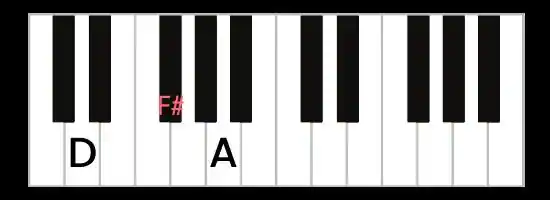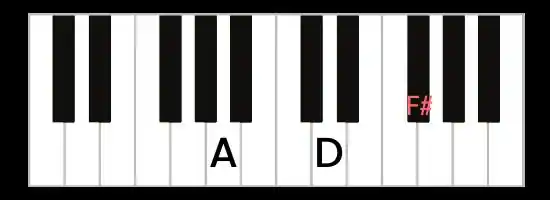Have you just begun to play the piano? Do you want to learn how to play the D major chord? When I first started, this chord seemed a bit hard to master. However, with time, it naturally fits in my hands. If you’re eager to play the D major chord, you first need to understand its positioning. It’s a triad composed of a major third (F#), a root (D), and a perfect fifth (A).
If you are a beginner and observe the keyboard closely, you’ll notice groups of black keys arranged in twos and threes. Below, I’ll provide a comprehensive guide on how to play the D major chord on the piano.
How to Play the D Major Chord on the Piano
To play the D major chord, you need to be familiar with its composition on the piano. The chord consists of three primary notes: A, F#, and D. This is why the D major chord is referred to as a triad.
As a musician, to play the D major chord, you should press all three notes simultaneously. You’ll find these notes between groups of black keys.
The Notes in a D Major Chord
The D major chord includes three main notes: D, A, and F#. Here, D is the root, F# is the major third, and A is the perfect fifth.

Finding The Notes
- Root (D): Located directly after the C note, between any two black keys.
- Major Third (F#): From the D note, move to the next white note to find E, then half a step further for F#.
- Perfect Fifth (A): From F#, move up two white notes.
D Chord Piano Finger Positions
The finger positions for the D chord vary between the right and left hands. I prefer using the left hand to play the D major chord:
- A – First finger (1)
- F# – Third finger (3)
- D – Fifth finger (5)
For the right hand, the positions are reversed:
- A – Fifth finger (5)
- F# – Third finger (3)
- D – First finger (1)
What Are the Inversions of the D Major Chord?
Playing the First Inversion of the D Major Chord
In the first inversion, F# becomes the lowest note. Here’s how to play it with your right hand:

- D – Fifth finger (5)
- A – Second finger (2)
- F# – First finger (1)
Playing the Second Inversion of the D Major Chord
In the second inversion, A is the lowest note. Here’s how to play it with your right hand:

- F# – Fifth finger (5)
- D – Third finger (3)
- A – First finger (1)
Frequently Asked Questions
Q1. What are the chords in the key of D major?
Ans.
- D major (I)
- E minor (ii)
- F# minor (iii)
- G major (IV)
- A major (V)
- B minor (vi)
- C# diminished (vii)
Q2. How can you play the D chord with the left hand?
Ans. Place your first finger on A, the third on F#, and the fifth on D.
Q3. What notes make up the D major chord?
Ans. The chord is composed of the notes F#, A, and D.
Ending Note on the D Major Chord Playing the D major chord on the piano is always a delight. I have created many new tunes and pieces of music using this chord. You can do the same and perhaps even innovate beyond what I have achieved. Best of luck!
Related Posts:-How To Play Piano Man On Harmonica

